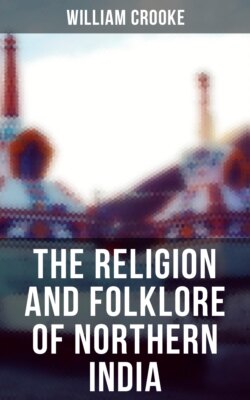Читать книгу The Religion and Folklore of Northern India - William Crooke - Страница 57
На сайте Литреса книга снята с продажи.
Hanumân.
ОглавлениеTable of Contents
First among the heroic godlings is Hanumân, “He of the large jaws,” or, as he is generally called, Mahâbîr, the “great hero,” the celebrated monkey chief of the Râmâyana, who assisted Râma in his campaign against the giant Râvana to recover Sîtâ. Hardly any event in his mythology, thanks to the genius of Tulasî Dâs, the great Hindi poet of Hindustân, is more familiar to the Hindu peasant than this. It forms the favourite subject of dramatic representation at the annual festival of the Dasahra. There Hanumân, in fitting attire, marches along the stage at the head of his army of bears and monkeys, and the play ends with the destruction of Râvana, whose great body, formed of wickerwork and paper, is blown up with fireworks, amid the delighted enthusiasm of the excited audience.
It is almost certain that the worship of Hanumân does not come down from the earliest ages of the Hindu faith, though it has been suggested that he is the legitimate descendant of Vrisha-kapi, the great monkey of the Veda.3 Besides being a great warrior he was noted for his skill in magic, grammar and the art of healing. Many local legends connect him with sites in Northern India. Hills, like the Vindhya and that at Govardhan, are, as we have seen, attributed to him or to his companions. The more extreme school of modern comparative mythologists would make out that Hanumân is only the impersonation of the great cloud-monkey which fights the sun.4
But the fact of monkey-worship is susceptible of a much simpler explanation. The ape, from his appearance and human ways, is closely associated with man. It is a belief common to all folk-lore that monkeys were once human beings who have suffered degradation,5 and according to one common belief stealers of fruit become monkeys in their next incarnation. But the common theory that the monkey is venerated in memory of the demigod Hanumân is, as Sir A. Lyall6 remarks, “plainly putting the cart before the horse, for the monkey is evidently at the bottom of the whole story. Hanumân is now generally supposed to have been adopted into the Hindu heaven from the non-Aryan or aboriginal idolaters; though, to my mind, any uncivilized Indian would surely fall down and worship at first sight of an ape. Then there is the modern idea that the god was really a great chief of some such aboriginal tribe as those which to this day dwell almost like wild creatures in the remote forests of India; and this may be the nucleus of fact in the legend regarding him. It seems as if hero-worship and animal-worship had got mixed up in the legend of Hanumân.”
At the same time, it must be remembered that the so-called Aryans enjoy no monopoly of his worship. He is sometimes like a tribal godling of the aboriginal Suiris, and the wild Bhuiyas of Keunjhar identify him with Borâm, the Sun godling.7 It is at least a possible supposition that his worship may have been imported into Brâhmanism from some such source as these.
HANUMÂN AND HIS PRIEST.
